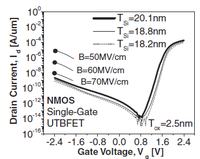nitishn5
Full Member level 6
- Joined
- Mar 27, 2011
- Messages
- 365
- Helped
- 91
- Reputation
- 184
- Reaction score
- 98
- Trophy points
- 1,308
- Location
- Bangalore, India, India
- Activity points
- 4,129
How accurate is the leakage models of both core and high voltage devices in the TSMC 180nm process?
In my simulations, the numbers are very small and of the order of 10s of femto-amps on a node with just two small drains connected to it.
But silicon shows an extra current in the order of 100s of pico-amps unaccounted for.
I was not expecting the leakage current of some small devices to become so large.
This shows an increase by at least 3 orders of magnitude.
Are the models that bad for such a mature process? Or are these numbers so small that this is the best accuracy that can be achieved?
In my simulations, the numbers are very small and of the order of 10s of femto-amps on a node with just two small drains connected to it.
But silicon shows an extra current in the order of 100s of pico-amps unaccounted for.
I was not expecting the leakage current of some small devices to become so large.
This shows an increase by at least 3 orders of magnitude.
Are the models that bad for such a mature process? Or are these numbers so small that this is the best accuracy that can be achieved?
